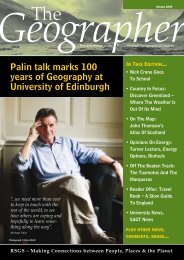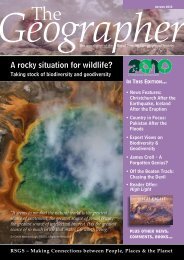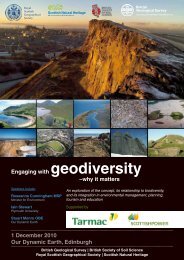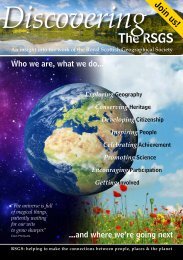Summer - Royal Scottish Geographical Society
Summer - Royal Scottish Geographical Society
Summer - Royal Scottish Geographical Society
You also want an ePaper? Increase the reach of your titles
YUMPU automatically turns print PDFs into web optimized ePapers that Google loves.
An Expert View: Women in Geography<br />
Women in Geography<br />
“...women<br />
have been<br />
producers<br />
and<br />
teachers of<br />
geographical<br />
knowledge<br />
since the<br />
foundation<br />
of the British<br />
geographical<br />
societies and<br />
university<br />
departments<br />
of geography<br />
– and a<br />
significant<br />
number of<br />
these women<br />
were born<br />
and/ or lived<br />
and worked<br />
in Scotland.”<br />
It is a common misperception<br />
amongst undergraduates that<br />
women geographers only began<br />
contributing to the discipline<br />
in the 1970s. Members of the<br />
<strong>Royal</strong> <strong>Scottish</strong> <strong>Geographical</strong><br />
<strong>Society</strong> are better placed than<br />
most to appreciate that this<br />
is not the case: women have<br />
been producers and teachers<br />
of geographical knowledge<br />
since the foundation of the<br />
British geographical societies<br />
and university departments of<br />
geography – and a significant<br />
number of these women were<br />
born and/ or lived and worked<br />
in Scotland. Mary Somerville,<br />
born in Jedburgh, wrote Physical<br />
Geography in 1848, which was<br />
credited with being the first<br />
British text of that title and<br />
welcomed by the geographical<br />
establishment and a wider<br />
readership, going to seven<br />
editions. Isabella Bird’s travel<br />
accounts were immensely<br />
popular in the second half of the<br />
nineteenth century and she was<br />
honoured by the RSGS.<br />
Marion Newbigin is often the<br />
first woman’s name to spring<br />
to mind in association with the<br />
society. She was born in Alnwick<br />
and graduated BSc and DSc<br />
from Aberystwyth, but lived and<br />
spent most of her professional<br />
life in Edinburgh, where she<br />
worked on Challenger findings<br />
and taught at the Extra Mural<br />
School of Medicine for Women.<br />
More than that, her career was<br />
inextricably connected with the<br />
<strong>Society</strong> through her 32 years<br />
as assistant and editor of the<br />
<strong>Scottish</strong> <strong>Geographical</strong> Magazine<br />
and it is for her influence<br />
as editor she is principally<br />
remembered as a ‘founding<br />
parent’ of <strong>Scottish</strong> geography. In<br />
1923 Newbigin and travel writer<br />
Ella Christie were the first women<br />
to sit on the <strong>Society</strong>’s Council<br />
(the Manchester <strong>Geographical</strong><br />
<strong>Society</strong> appointed women to<br />
its first council in 1884, but<br />
it was 1930 before the <strong>Royal</strong><br />
<strong>Geographical</strong> <strong>Society</strong> followed<br />
suit). Newbigin was also a prolific<br />
author who influenced debates on<br />
regional geography, the scientific<br />
method in geography and<br />
teaching techniques, as well as<br />
initiating much of what became<br />
biogeography.<br />
This interest in links between<br />
plants, animals and geography<br />
influenced two other women<br />
who were to be involved with<br />
editing the SGM. Isobel Wylie<br />
Hutchison, Arctic traveller and<br />
plant collector, became Honorary<br />
Editor of the journal between<br />
1944 and 1953 (the first woman<br />
to hold this post); and leading<br />
biogeographer Joy Tivy, Lecturer<br />
and later Professor of Geography<br />
at the University of Glasgow, was<br />
editor 1954-63. Lois Latham,<br />
Harriet Wanklyn and Catherine<br />
Snodgrass were also editors for<br />
brief periods. Combined, women<br />
served the SGM in editorial<br />
capacities for 60 years in the<br />
early to mid 20th century.<br />
Edinburgh University had a<br />
strong record of appointing<br />
women academics in the interand<br />
post-war years. Alice Lennie,<br />
assistant to George Chisholm,<br />
may only be recognised by a<br />
few, but the names of Winifred<br />
Day, Betty Third, Kay MacIver,<br />
Swanzie Agnew and Catherine<br />
Snodgrass will be familiar to<br />
many and no doubt bring back<br />
memories of lectures, map<br />
classes and field work. As head<br />
of department MacIver directed<br />
the growth of geography at St<br />
Andrews; Swanzie Agnew taught<br />
at Fort Hare in South Africa,<br />
only to be deported when the<br />
university was closed down as a<br />
centre of anti-apartheid politics;<br />
Snodgrass was also deeply<br />
political, expressed through<br />
her commitment to researching<br />
<strong>Scottish</strong> geography and support<br />
for the <strong>Scottish</strong> National Party.<br />
Peggie Hobson, developed a<br />
love for Scotland when a student<br />
and she spent eight years<br />
lecturing at St Andrews 1945-<br />
53, publishing several articles<br />
in the SGM on the parishes of<br />
Sutherland. Although she spent<br />
most of her professional life in<br />
South Africa and London, Hobson<br />
retired to Edinburgh and will be<br />
remembered for curating the<br />
society’s centenary exhibition<br />
on The Spirit of Adventure and<br />
Discovery 1884-1984, including<br />
a special section on women<br />
explorers.<br />
There are many other women<br />
who contributed to geographical<br />
knowledge and the work of<br />
the society, but I hope this<br />
sketch gives a flavour of the<br />
variety of their interests and<br />
the significance of their work.<br />
However, when looking at the<br />
history of the discipline there are<br />
always puzzles remaining: why<br />
was there a thirty two year hiatus<br />
between female editors of the<br />
SGM 1967-1999 and why did the<br />
Edinburgh department go from 3<br />
female lecturers in the 1950s to<br />
none in the early 1960s? Answers<br />
on a postcard please!<br />
Avril Maddrell<br />
Department of Geography and<br />
Environmental Management,<br />
University of the West of England<br />
(avril.maddrell@uwe.ac.uk)<br />
To receive 20%<br />
off this title<br />
visit www.wiley.com<br />
and enter promotional code<br />
VA189 at the checkout.*<br />
*Expires Jan 2010








